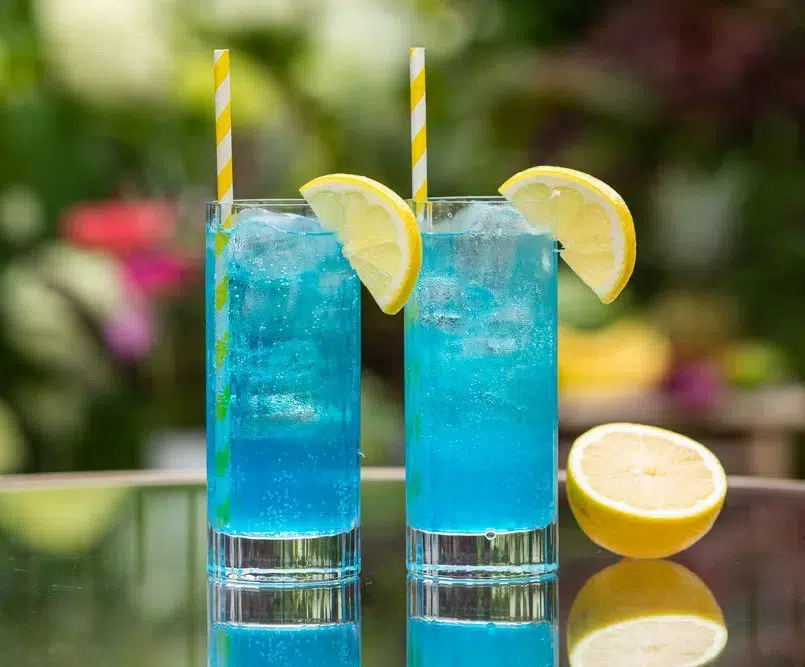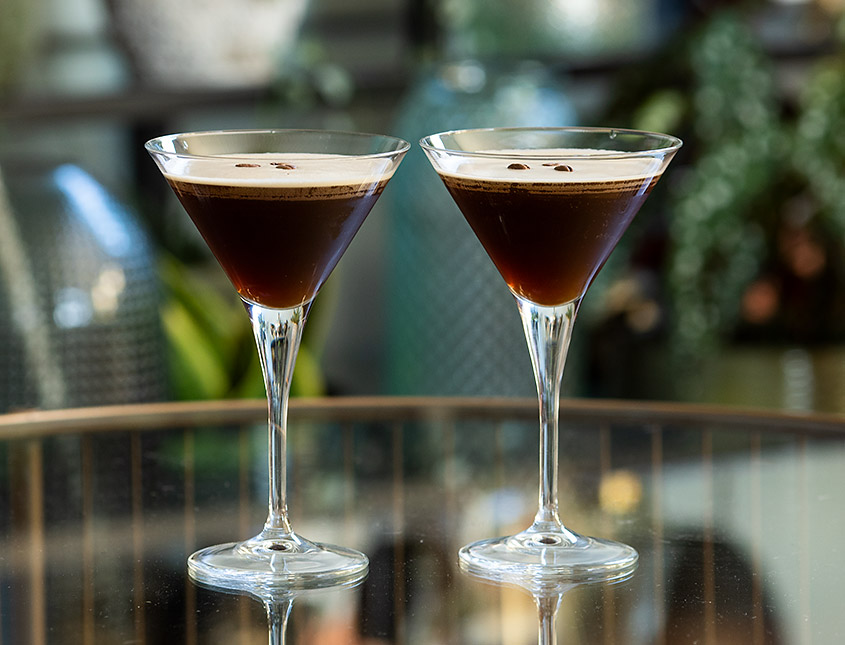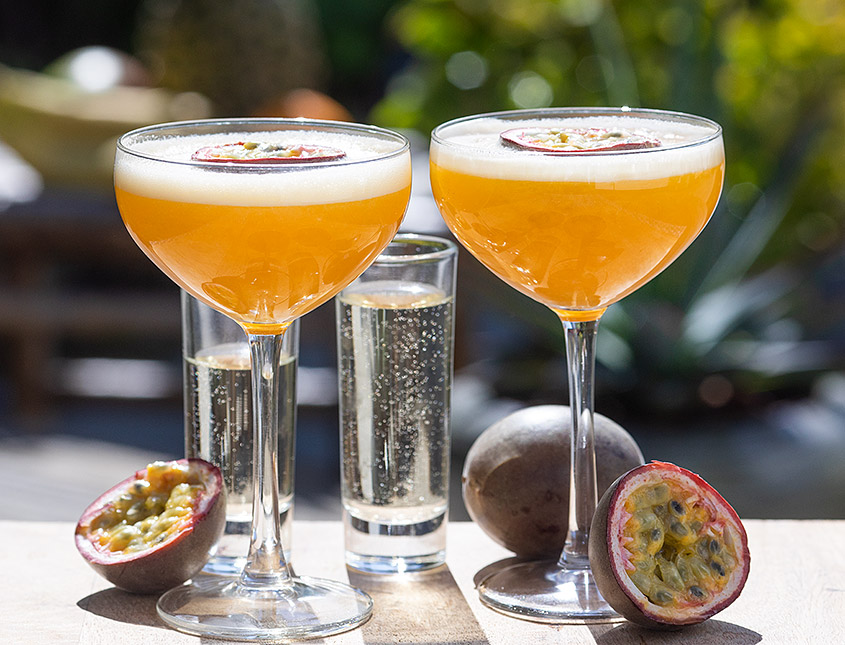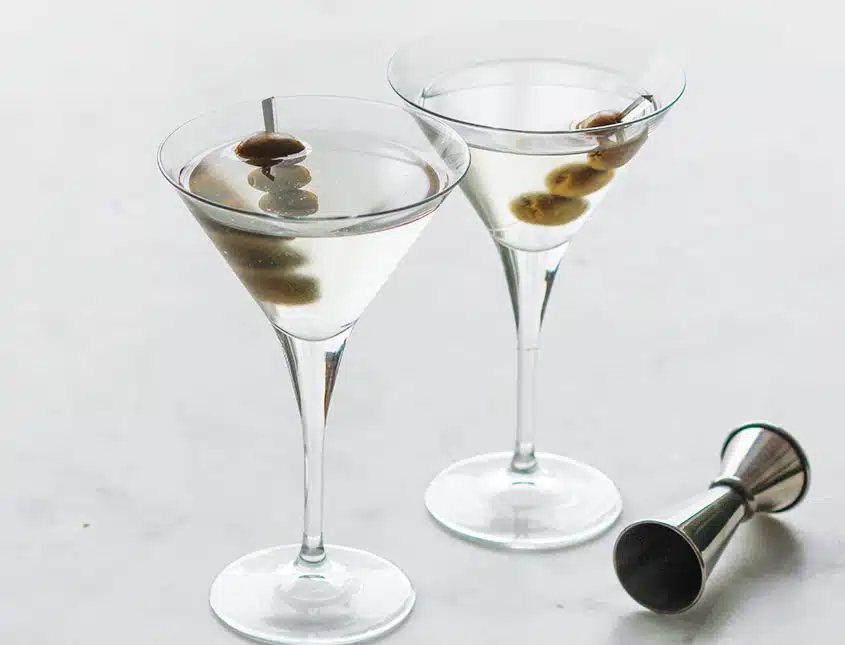
Here's how to make the classic Martini yourself: Tip: for the best result, don't shake the Martini, but stir it. How do you make a Martini in style? It doesn't get classier than the classy Martini. The iconic "shaken not stirred" Martini has become one of the trademarks of style and coolness from James Bond [...]
Ingrediënten
- Dry gin 60 ml
- White vermouth 30 ml
- Olives 3 pieces
Bar tools
- Mixing glass
- Bar spoon
- Strainer
How to
- Stir in mixing glass with ice
Cocktailrecept Martini recipe
- Start with a classy Martini glass that you chill with ice
- Use a mixing glass or mixing beaker with ice
- Pour 60 ml of gin and 30 ml of vermouth into it using a jigger
- Stir well with a bar spoon to mix everything thoroughly and chill it
- Pour from the mixing glass into the martini glass using a strainer
- Add an olive skewer for the classic Martini experience
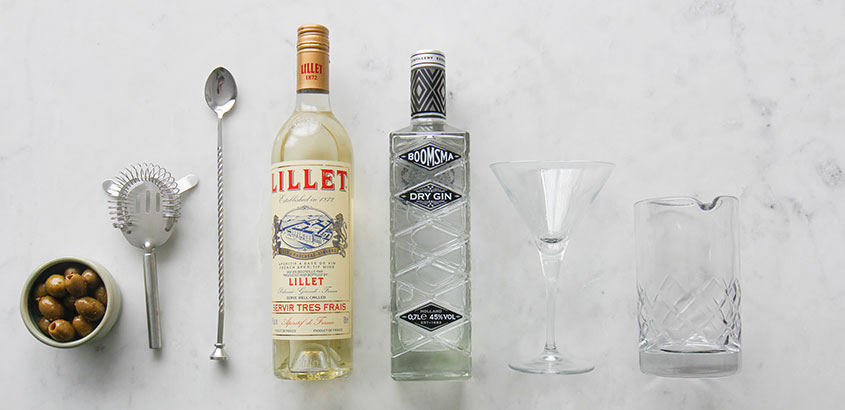
Here’s how to make the classic Martini
Tip: For the best result, don’t shake the Martini, but stir it.
How do you make a Martini in style?
It doesn’t get classier than the classy Martini. The iconic “shaken not stirred” Martini has become one of the trademarks of style and coolness thanks to James Bond in his 007 films. I’ve made it myself several times. Naturally, I’ve also made it once entirely in style, in a tuxedo, the classic way by stirring it in a mixing glass.
The best way to make a Martini is by stirring. This way, the cocktail becomes much less diluted compared to shaking it with ice. Maintain a ratio of 2:1, with 2 parts dry gin to 1 part vermouth.
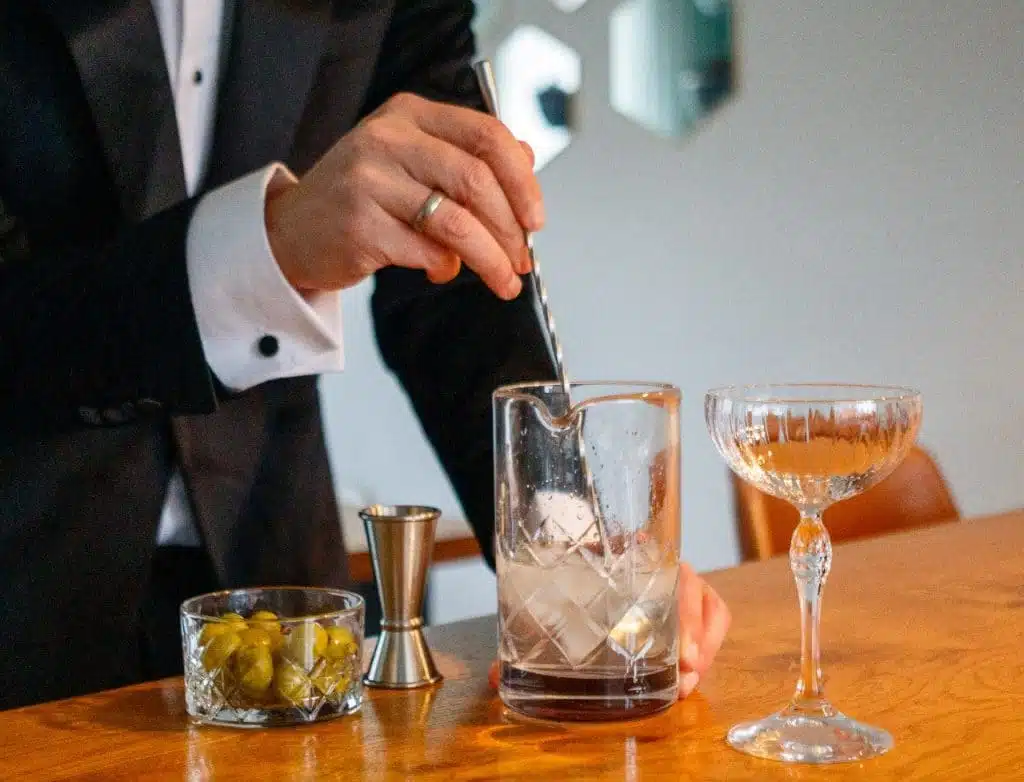
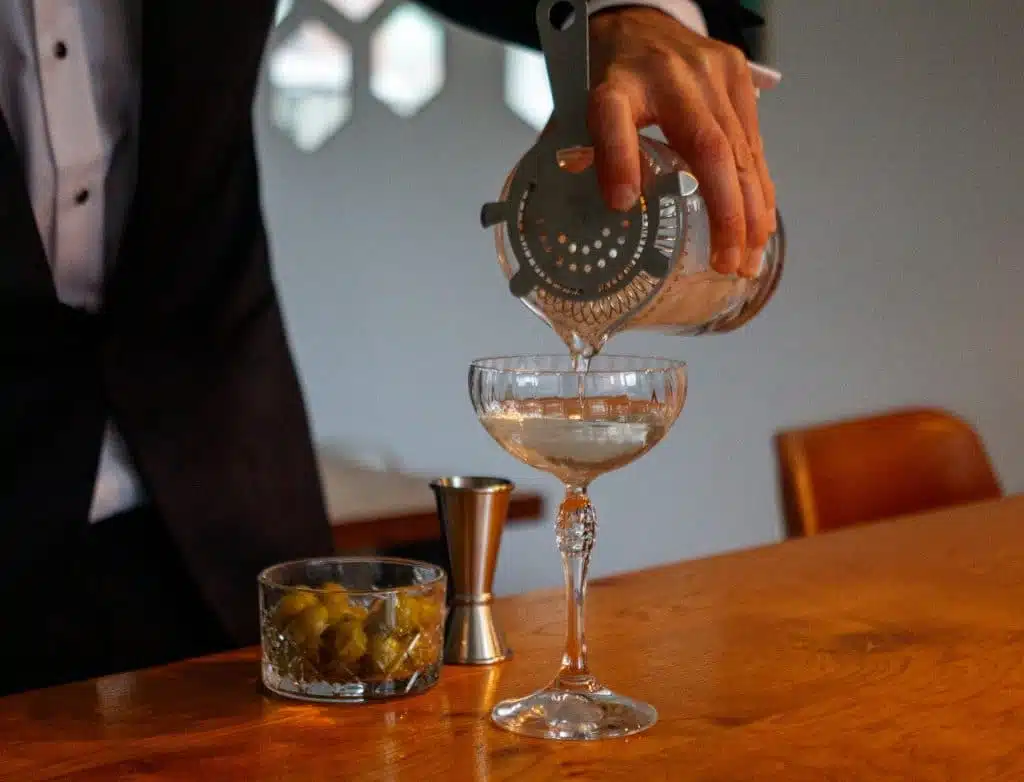
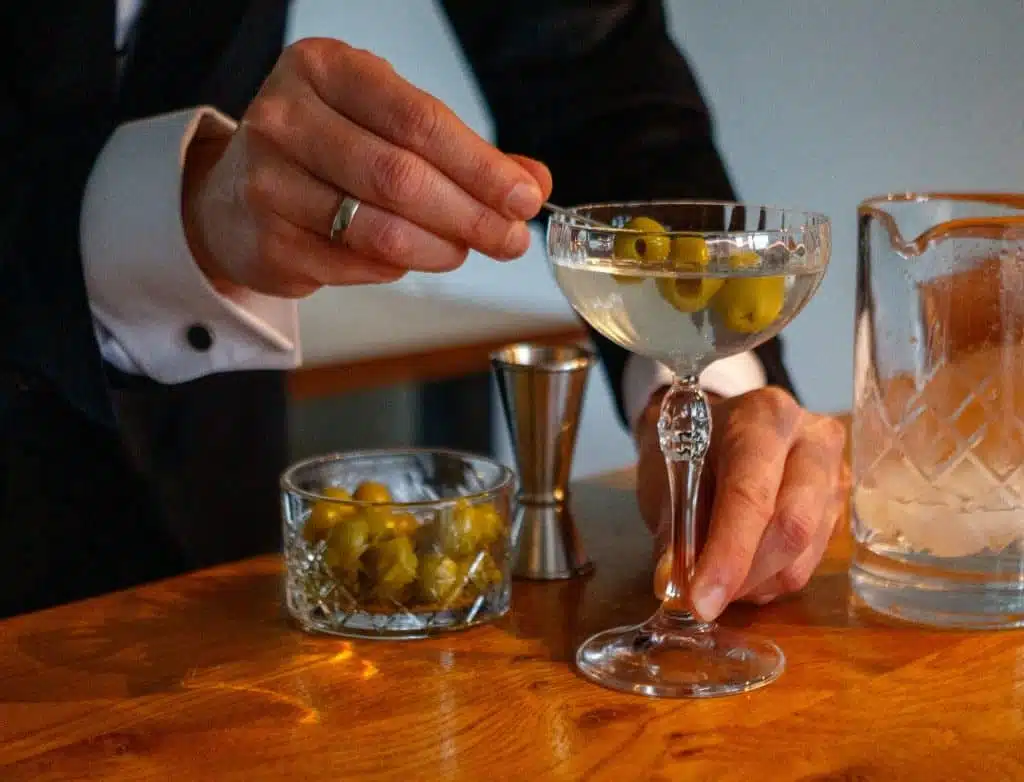
Shaken or stirred?
James Bond insists on his Martini being “shaken, not stirred.” However, technically, it’s actually better to stir the cocktail in a mixing glass with ice. Shaking releases more water, making it more diluted. Purists opt for stirring instead of shaking.
Origin: where does the name Martini come from?
To trace the origins of the Martini as we know it today, we go back to the 19th century. After a hard day’s work, a miner named Martinez walked into a bar and was served a strong cocktail with gin, vermouth, and maraschino (cherry liqueur). The cocktail was named after the miner, but after having a few of these cocktails, he could no longer pronounce the “z.” And thus, the Martinez became the Martini.
The Martini evolved in taste. With the introduction of London Dry Gins, the sweet cherry liqueur disappeared, and this cocktail was made in the traditional ratio of 2:1. 2 parts gin, 1 part vermouth.
The martini glass
The Martini is naturally enjoyed from a fancy Martini glass. This is a thin and elegant cocktail glass with a distinctive V-shape. The shape of this glass allows the aroma and flavour to develop well. The advantage of the stem is that it prevents the glass from warming up with your body temperature when held there.
Martini has become a generic term for cocktails that you drink from a Martini glass. Think of the Pornstar Martini, Espresso Martini, Chocolate Martini, etc. The rule for the official Martini remains making it with 2 parts gin and 1 part vermouth.
Which gin do you use for a Dry Martini?
The martinis of the past, however, were not dry. It wasn’t until the arrival of London Dry Gins that the founders began mixing the Martini with dry vermouth. The gin is crucial for your Martini because it comprises most of it. Opt for a dry gin, and you’ll get a Dry Martini. If you prefer a savory gin with olive notes, consider Gin Mare. For a more citrusy taste, go for Tanqueray, Malfy, or Bombay.
Which vermouth do you use for a Martini?
Vermouth is a fortified wine (15% alcohol). It is blended with sugar and aromatic herbs. The most famous vermouth brand is Martini. I’m not a Vermouth connoisseur, but I find Mancino, with rich flavours like sage, oregano, and lemongrass, to complement a Martini with a savory taste. Lillet, with its floral and soft taste, pairs better with citrus flavours.
Perfect serve with olives
To accentuate the briny taste of the Martini, olives are often chosen as garnish. They complement the flavors well and add a touch of sophistication. It’s fun to experiment with variations, such as using cocktail onions or a combination of cocktail onion and a small gherkin.
Tip: If you always garnish with olives, try adding a subtle gherkin with cocktail onion as a savory alternative for your garnish.
Bekende varianten: Dirty Martini, Vesper Martini, Saketini
The Dirty Martini is a variation of the Martini or Dry Martini. In a Dirty Martini, you add 1 bar spoon of olive brine. This makes it cloudy or “dirty”. If you enjoy olives, it’s a tasty addition to your Martini.
Also famous, notably from the Bond film “Casino Royale,” is the Vesper Martini. In this variation, besides gin, vodka, Lillet Blanc, and a lemon garnish are used.
The Saketini is a Japanese variant of the Martini made with sake. I have sake in the fridge for my Lychee Martini, but I haven’t dared to make this cocktail yet.
Common Mistakes
The most common mistake with these iconic cocktails is shaking the cocktail. Additionally, here are a few other common errors to watch out for:
- Incorrect proportions: Not adhering to the traditional ratio of gin to vermouth (2:1) can result in an imbalanced flavour.
- Improper temperature: A Martini should be served well-chilled, preferably in an ice-cold glass. Serving a Martini at room temperature can negatively affect the experience.
- Over or under stirring: Stirring the Martini is important to blend the ingredients and create the right texture. You can stir too little or too much. Aim for about 30 seconds.
- Use of inferior ingredients: Using low-quality gin, vermouth, or additions such as olives or lemon peel can diminish the overall quality of the Martini.
- Excessive additions: Overdoing it with additions like olives or lemon peel can overpower the subtle flavors of the Martini. Keep it simple.
- Underestimating vermouth: Vermouth is an essential part of the Martini. Therefore, opt for a good vermouth so that it stands up to the gin.


